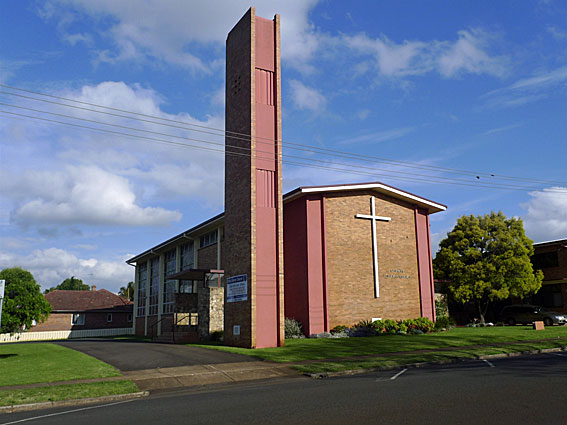
St Paul's Lutheran Church, Toowoomba
[Photograph by Trevor Bunning (November 2011)]

St Paul's Lutheran Church, Toowoomba
[Photograph by Trevor Bunning (November 2011)]
Historical and Technical Documentation by Geoffrey Cox
© OHTA 2012 (last updated June 2012)
There were German settlers on the Darling Downs from 1854 onwards, initially brought out as shepherds or boundary riders on sheep stations. A large number of German immigrants arrived in the 1860s and early 1870s under an expanded immigration policy of the newly independent Queensland government, and these were followed by Scandinavians in the 1870s.1 Land had been granted here for the purposes of the Lutheran Church in the 1850s, and the congregation of St Paul's was officially established in 1863. A new brick church was erected in 1877,2 possibly designed by the Toowoomba architect, James Marks.3 The present church was opened and dedicated on 21 June 1959. The great northern window of the building features a series of twelve medallions each depicting a period in the life of Jesus.
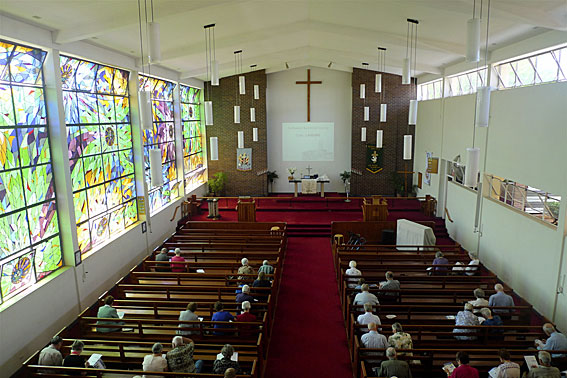
Interior of St Paul's Lutheran Church, Toowoomba
[Photograph by Trevor Bunning (November 2011)]
The organ in St Paul's Church is believed to have been built by Aug. Laukhuff of Weikersheim, West Germany, although the arrangements for its purchase and installation have been somewhat obscured. It was purchased in Germany, but the components of the instrument were imported as 'parts' by Whitehouse Bros of Brisbane, thereby avoiding import duty.4 There has never been a builder's plate on the instrument. It was installed by Whitehouse Bros in 1927 in the former church on the present site.5 Judging from its appearance, the casework may have been provided by Whitehouse Bros.
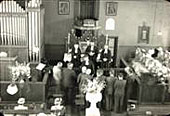
The organ in the former (1877) church building
[Photograph from St Paul's church website - accessed November 2011]
The instrument appears to have been similar in many respects to the one by E.F. Walcker & Co. of Germany installed some sixteen years earlier at St Andrew's Lutheran Church in Brisbane: Both included a roll-playing mechanism, and the stop-lists were almost identical, with the pipework entirely enclosed in the swell box apart from that of the Great Open Diapason 8ft stop. The specification of the Toowoomba instrument is believed to have been as follows:
| GREAT 1. Open Diapason 2. Flute Amabile 3. Gamba 4. Dulciana 5. Principal 6. Mixture SWELL 7. Flute Amabile 8. Gamba 9. Vox Celeste 10. Rohr Flute PEDAL 11. Bourdon COUPLERS Great to Pedal Swell to Pedal Swell to Great |
8 8 8 8 4 III 8 8 8 4 16 |
(all pipework enclosed other than Open Diapason 8ft) A B A B |
Mechanical action
Roll-playing mechanism.6
The organ was rebuilt with electro-pneumatic action in 1959 by H.W. Jarrott of Brisbane, and installed in the present (new) church in time for its opening on 21 June that year.7 The original soundboard (which had served both manuals) was retained for the Swell, and a new one (secondhand from St Paul's Anglican Church, Ipswich) was provided for the Great, thus making provision for subsequent additions. The roll-playing mechanism was not retained.8 Amongst the stops added at this time was a Pedal Principal 8ft that had been built by Mr J. Peel of South Brisbane for the organ subsequently in Redeemer Lutheran Church, but never installed there.9
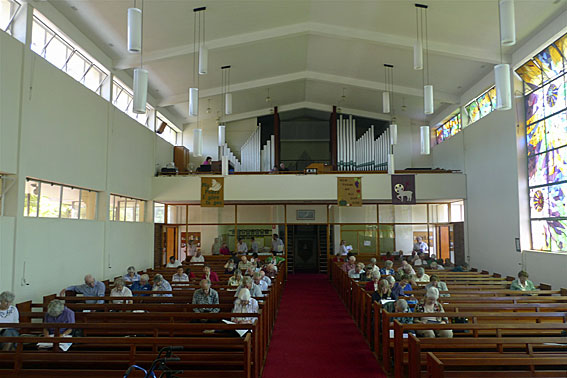
The reconstructed organ in the new church
[Photograph by Trevor Bunning (November 2011)]
Coinciding with the centenary of the church in 1963, further stops were added by Jarrott on the soundboards that had been prepared in 1959.10 The Great Mixture III was transferred to the Swell and four new stops were added: two on the Great (Clarabella 8ft & Fifteenth 2ft) and two on the Swell (Lieblich Gedackt 8ft & Oboe 8ft). There was still one spare slide on the Swell after the 1963 additions.11
The instrument was further enlarged in 1974-75 by Walter Emerson of Toowoomba. Emerson added four completely new stops to the Swell, and transferred the original Flute Amabile (which Jarrott had duplexed on the Great as 'Hohl Flute') from the Swell to the Great, mounting it on a separate chest. The 8ft octave of the original rank (in reality a Harmonic Flute) was used as the bass of the new Violin Diapason 8ft on the Swell. The duplexed stops between the Swell and Great, which Jarrott had retained, were removed, and the original Mixture III and Vox Celeste 8ft were discarded. The latter went to St Matthew's Anglican Church, Drayton. During the early 1980s, Emerson replaced the Great soundboard (ex. Ipswich) with a new one.12
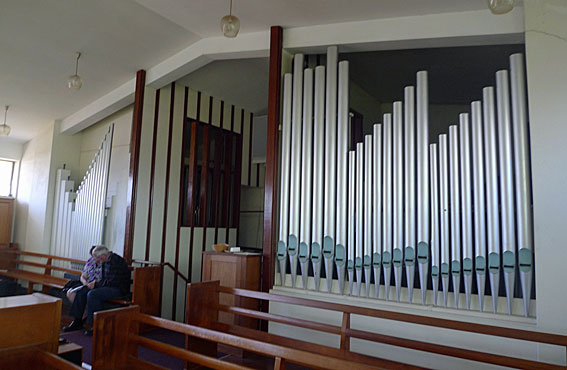
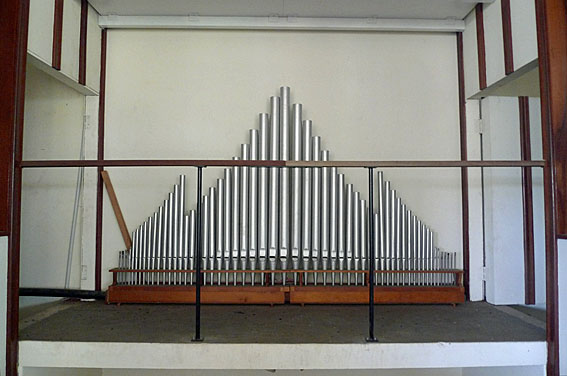
[Photographs by Trevor Bunning (November 2011)]
The specification is now as follows:
| GREAT Open Diapason Clarabella Dulciana Octave Flute Amible [sic] Fifteenth SWELL Violin Diapason Lieblich Gedackt Gamba Flute Gemshorn Sifflöte Zimbel Oboe PEDAL Bourdon Bass Flute Principal Quint |
8 8 8 4 4 2 8 8 8 4 2 1-1/3 II 8 16 8 8 5-1/3 |
A A A |
[old No 1] [1963] [old No 4] [old No 5] [old No 7] [1963] [1975] [1963] [old No 8] [old No 10] [1975] [1975] [1975] [1963] [old No 11] [1959] [1959] [made by J. Peel of South Brisbane] [1959/1975] [Quint 10-2/3 in 1959, altered in 1975] |
COUPLERS
Great to Pedal
Swell to Pedal
Swell to Great
Great Super
Swell Super
Swell Sub
Swell Super to Great
Super to Great
Swell Sub to Great
Electro-pneumatic action
3 thumb pistons to Great Organ
3 thumb pistons to Swell Organ
1 Manual pistons combined
1 General Cancel
1 Full Organ thumb piston (reversible)
1 Full Organ toe piston (reversible)
1 Great to Pedal thumb piston (reversible)
1 Great to Pedal toe piston (reversible)
1 Swell to Great thumb piston (reversible)
1 Swell to Great toe piston (reversible).13
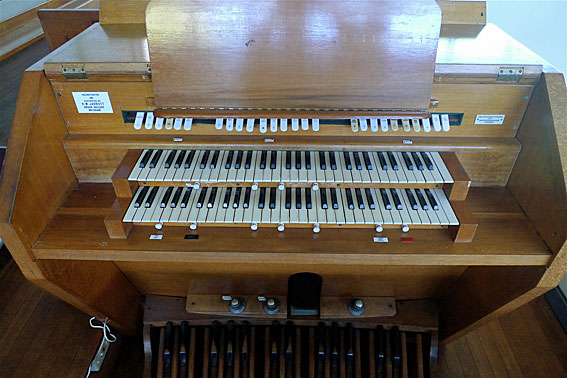
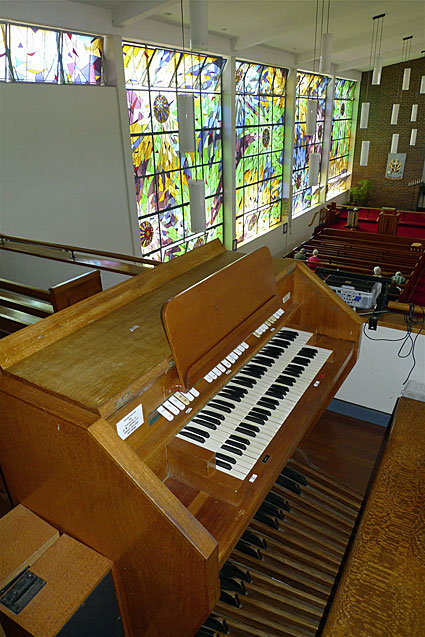
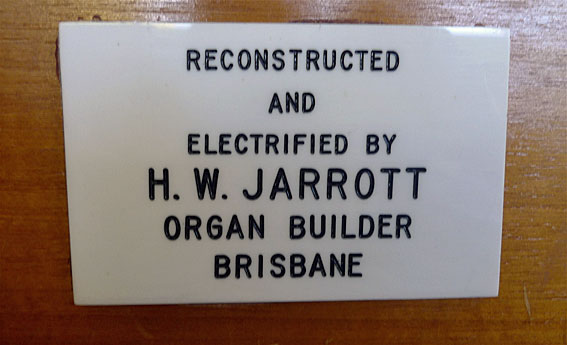
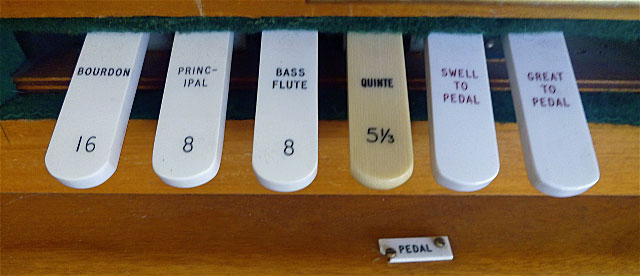

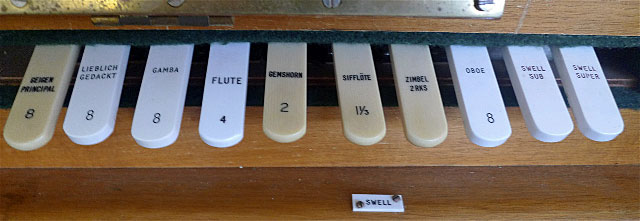
Console and stop-key details
[Photographs by Trevor Bunning (November 2011)]
______________________________________________________________________
1 Joyce Graetz, An Open Book: The Story of the Distribution and Production of Christian Literature by Lutherans in Australia (Adelaide: Lutheran Publishing House, 1988), pp. 15-55.
2 F. Otto Theile, One Hundred Years of the Lutheran Church in Queensland (Brisbane: UELCA, 1938), pp. 267-68; [email protected] The Queenslander (5 January 1878), p. 23.
3 Donald Watson & Judith McKay, Queensland Architects of the 19th Century: A Biographical Dictionary (Brisbane: Queensland Museum, 1994), p. 123.
4 Personal communication to G. Cox from H.W. Jarrott, February 1974. Mr J.H. Whitehouse jnr confirmed subsequently that the console was imported from Laukhuff. The pipework was identified by both Walter Emerson and H.W. Jarrott as originating from Laukhuff.
5 Whitehouse Bros List gives the following: 'New 1927. Retubing main tubes Console £17.15.0.'; Jacob Donges, St Paul's Lutheran Church, Toowoomba: Centenary 1863-1963 ([Toowoomba: Centenary Planning Committee of St Paul's Church, Toowoomba], 1963), pp. 7, 14.
6 Specification recalled by Walter Emerson, February 1974, with clarifications and further details supplied by H.W. Jarrott, February 1974, and Leslie W. Rub, March 1987 & June 2003.
7 Donges, op. cit., p. 9.
8 Personal communication to G. Cox from H.W. Jarrott, February 1974.
9 Personal communication to G. Cox from Leslie W. Rub, March 1987.
10 Donges, op. cit., p. 27.
11 Specification noted by G. Cox, with details supplied by H.W. Jarrott, February 1974.
12 Details supplied to G. Cox by Walter Emerson, Sept 1974 & May 1975, and Leslie W. Rub, June 2003.
13 Specification noted by G. Cox, 1974, with supplementary details as noted above.